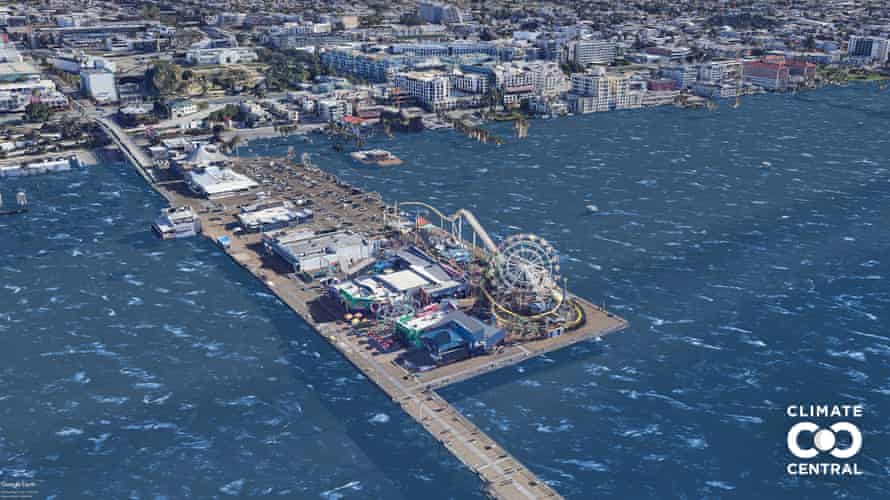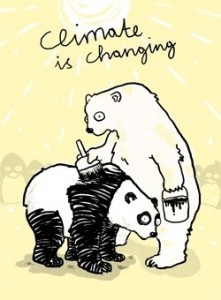 (Illustration: Famous Santa Monica, California, Pier with 1.5°C (2.7°F) rise in global temperatures, and found here).
(Illustration: Famous Santa Monica, California, Pier with 1.5°C (2.7°F) rise in global temperatures, and found here).
Way-windy and chilly this mid-day Tuesday here in California’s Central Valley, but nowhere as fierce as yesterday’s blustery time — this morning on our daily walk with Leroy (my daughter’s Basset hound/Greyhound mix) there was down tree limbs/debris along our path, a display of the day-before’s turbulence.
Weather is an extension and expression of the climate and California has had its share of environmental change in the last few years.
And it’s only going to get worse.
Also yesterday, another red-light warning on climate change — a report from the World Health Organization (WHO) says the accelerating climate crisis is mankind’s biggest problem to maintaining any kind of well being (staying alive):
“The burning of fossil fuels is killing us,” the report said.
“Climate change is the single biggest health threat facing humanity. While no one is safe from the health impacts of climate change, they are disproportionately felt by the most vulnerable and disadvantaged.”The report was published ahead of the United Nations Climate Change Conference in Glasgow, Scotland, which runs Oct. 31-Nov. 12.
“The COVID-19 pandemic has shone a light on the intimate and delicate links between humans, animals and our environment,” WHO Director General Tedros Adhanom Ghebreyesus said in a statement.
“The same unsustainable choices that are killing our planet are killing people.”
And the future is maybe yesterday’s tomorrow:
Based on current emissions, the Earth is expected to reach and even exceed 3C (5.4F) warming by 2100.
*This before/after visualization shows what will happen to Santa Monica Pier by then:https://t.co/Dmt1qYgORJ pic.twitter.com/w4Uz7uflBM— Jim Roberts (@nycjim) October 12, 2021
And this is not a CGI original (though, in reality, it is) and is based on hard science and the use of study after study on the predicated avenue of how our coastlines will handle sea-level rise as the world continues to warm — one good display of this angle is from the Guardian this morning:
The land on which 10-percent of the world’s population lives could be lost to sea level rise if carbon emission trends continue, new maps and visualizations show.
Fifty major cities, mostly in Asia, and at least one large nation on every continent but Australia and Antarctica are at risk. Many small island nations are threatened with near total loss of their land.
The collection of images and videos produced by the non-profit Climate Central visualize future sea level rise if the world fails to meet emissions reduction targets.
The images show what areas of the world can be saved and which could be lost, taking with them the heritage and history of these coastal communities.Meeting the most ambitious goals of the Paris climate agreement could reduce the sea level rise exposure by roughly half. But the world is not on course to limiting global warming to 1.5C (2.7F), as outlined in the 2015 Paris agreement.
Based on current emissions, the Earth is expected to reach and even exceed 3C (5.4F) warming by 2100.
…
“A picture is worth 1,000 words, or 1,000 years in this case,” the lead author of the paper, Benjamin Strauss, said. Strauss serves as the CEO and chief scientist at Climate Central.
While it will take centuries to reach the dire scenarios of cities underwater, the actions taken now and in the coming decades will determine how much of the coastline will be lost in the future.Next month, representatives from every country in the world will meet in Glasgow for the Cop26 climate conference, where parties will be expected to commit to goals in response to the ongoing climate emergency.
“The decisions that we make at Glasgow and the actions that we take this decade will ramify for hundreds and thousands of years,” Strauss said.
“This group is going to be remembered for what they chose: did you choose a thriving future with a livable climate or did you choose to drown the coastal places of the world?”
…
“It’s probably easier for people to think of sea level rise as a problem that you can solve, or that there’s a certain amount of fixed sea level rise that we can plan for,” said Strauss.
“But the truth is we’ve switched from a world where sea level was stable, to one where it is on a continual march upwards.”
Go read/view the whole piece, but keep in mind all that date/time shit about 2100 is really a way-optimistic and hope-filled reporting as the reality is too-well-along for such shit. One big item I’ve noticed in the last decade or two concerning climate-science research/studies is the continual underplaying the results — nearly in all studies of climate change there’s a note in various word usages but the meaning is the same: Situation is worse than was earlier forecast.
Hard to handle those freaking ‘feedback loops,’ for instance.
Especially if a massive chunk of the planet has already felt the consequences of a warming world in many different, diverse forms from flooding, outrageous extreme heat, and storms to drought and economic bullshit, it’s all connected to a out-of-control CO2 emissions history.
A historical, interlocking study was released yesterday at Nature Climate Change gauging climate change’s fallout already, and the world is just cranking it up — snips from The Washington Post:
After using machine learning to analyze and map more than 100,000 studies of events that could be linked to global warming, researchers paired the analysis with a well-established data set of temperature and precipitation shifts caused by fossil fuel use and other sources of carbon emissions.
These combined findings — which focused on events such as crop failures, floods and heat waves — allowed scientists to make a solid link between escalating extremes and human activities.
They concluded that global warming has affected 80-percent of the world’s land area.“We have a huge evidence base now that documents how climate change is affecting our societies and our ecosystems,” said lead author Max Callaghan, a researcher at the Mercator Research Institute on Global Commons and Climate Change in Germany.
The study provides hard numbers to back up the lived experiences of people from New York City to South Sudan.
“Climate change,” Callaghan said, “is visible and noticeable almost everywhere in the world.”The findings come amid a major push to get countries to commit to more ambitious climate goals ahead of a United Nations summit in Glasgow, Scotland, next month. Research shows that existing pledges will put the planet on track to heat up about 2.7 degrees Celsius (4.9 degrees Fahrenheit) by the end of the century — a level of warming that would lead to drastic food and water shortages, deadly weather disasters, and catastrophic ecosystem collapse.
And a study within that same particular study indicated just what the WHO reported — hazards of climate change is affecting poor people in poor places fast, now and bad. Details at CNN, also from yesterday afternoon:
Scientists using artificial intelligence to sift through around 100,000 climate studies were trying to put a number on how many people in the world were already experiencing the impacts of the climate crisis.
Instead, they discovered something else: there is a worrying inequality in the world of climate science.
Climate change studies are twice as likely to focus on wealthier countries in Europe and North America than low-income countries like those in Africa and the Pacific Islands. That blind spot is a problem, as the Global South is and will continue to be more profoundly impacted by the climate crisis than wealthier countries.
The ability to link the climate crisis to real-world impacts has grown dramatically in the past decade, as more people face the consequences of a warming planet, including deadly floods, destructive wildfires and crippling heat.
But it has been a challenge to collect and scrutinize the vast amount of research, to fully understand the global impact.
…
“There’s just so much climate science produced, like tens of thousands [of studies], and getting to grips with this evidence is really difficult,” Max Callaghan, lead author of the study and a researcher at the Mercator Research Institute on Global Commons and Climate Change, told CNN.
“So we trained the machine learning algorithm to predict the areas that we didn’t have time to look at — which is most of them.”Compiling the results of all of those studies would suggest a vast majority of the world — 80-percent of land area, where 85-percent of the world’s population lives — is experiencing the effects of the climate crisis right now. It’s a large percentage, but experts know the true number is even higher.
…
Friederike Otto, co-lead of the World Weather Attribution initiative, who was not involved with the machine-learning research, also said the study’s estimate is likely too low.
Over the years, climate scientists like Otto have been saying the climate crisis will leave no place in the world untouched.
“The study focused on changes in mean temperature and precipitation, rather than extremes, but we know that heat extremes are changing faster than mean temperatures and that heat extremes are increasing almost everywhere,” Otto told CNN.
“It is likely that nearly everyone in the world now experiences changes in extreme weather as a result of human greenhouse gas emissions.”
And maybe/hopefully not a full-blown out CGI future:
Here we are, of course, once again…
 (Illustration out front by Handoko Tjung, found here)
(Illustration out front by Handoko Tjung, found here)